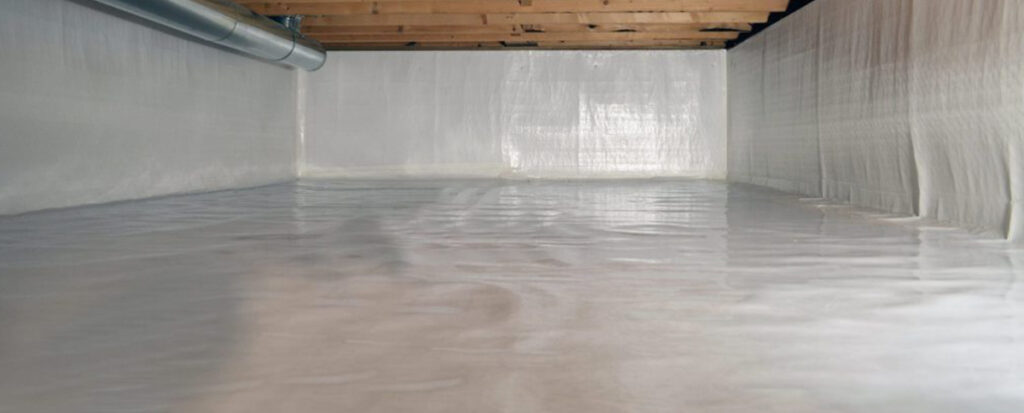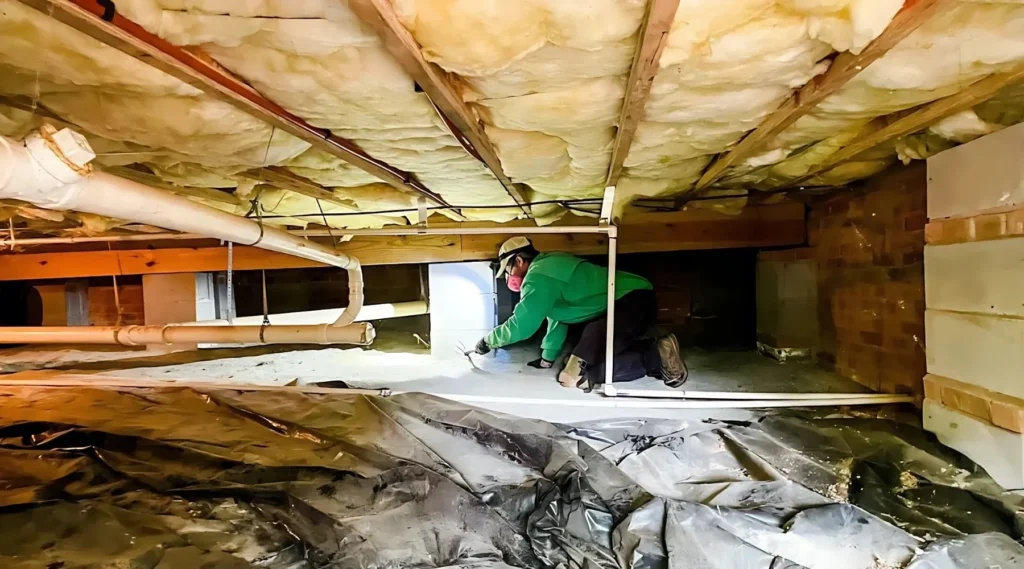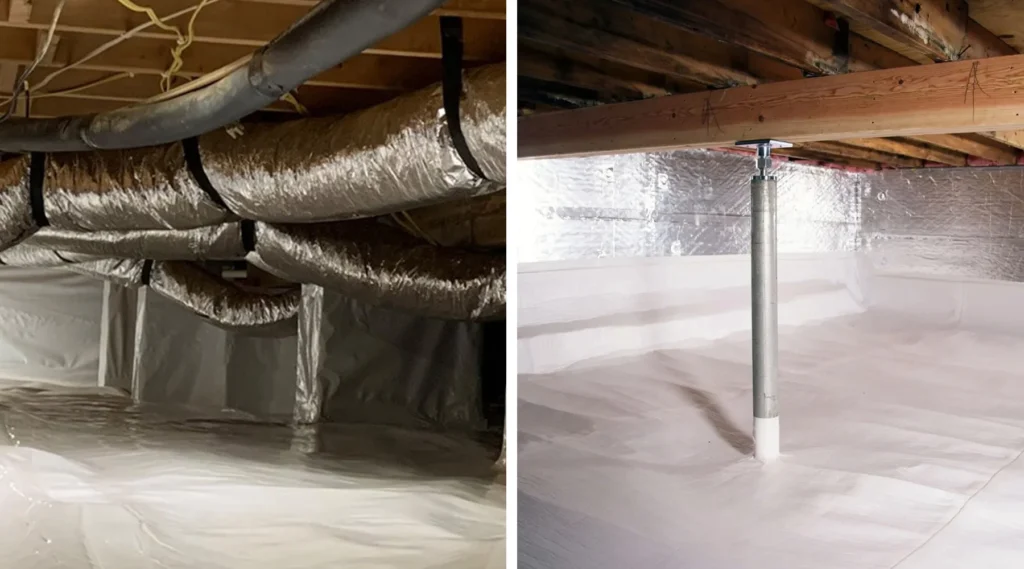If your crawl space is damp, musty, or causing indoor air quality issues, you’re not alone. Many homeowners across the Southeast face problems with moisture, mold, and energy loss under their homes. Crawl space encapsulation is a proven way to solve those issues—but is it something you have to do, or is it just a smart long-term investment?
Let’s break it down.
What Is Crawl Space Encapsulation?
Crawl space encapsulation is a modern approach to managing moisture, air quality, and energy efficiency in homes with crawl spaces. Unlike traditional vented crawl spaces, which attempt to dry out the area by circulating outside air, encapsulation seals the crawl space off from the exterior environment to create a dry, conditioned space.
Defining Crawl Space Encapsulation
Crawl space encapsulation is the process of sealing your crawl space to protect it from outside air, moisture, and pests. It transforms your crawlspace foundation into a clean, controlled environment—no more dirt floors, standing water, or musty odors.
This isn’t just about comfort. It directly impacts your home’s structure, air quality, and energy bills.
Key Components of an Encapsulated Crawl Space

A proper encapsulation system includes:
- Vapor Barrier – Heavy-duty plastic lining that covers the floor and walls to block ground moisture.
- Sealed Vents – Prevents humid air from entering through exterior wall vents.
- Wall Insulation – Adding crawlspace insulation helps maintain temperature stability and boosts efficiency.
- Moisture Control System – This may include a dehumidifier or drainage solution to prevent mold in crawl space areas.
- Airtight Access – The crawlspace entry is sealed with a secure, insulated door to stop air and pests.
Vented vs. Encapsulated Crawl Spaces: What’s the Difference?
The primary difference between vented and encapsulated crawl spaces lies in their approach to moisture and air management, leading to significant distinctions in their performance, benefits, and drawbacks.
Traditional Vented Crawl Spaces
Older homes often have vented crawlspaces. The thinking used to be that air circulation would dry out moisture, but in humid climates like Georgia or the Carolinas, this often backfires. Instead, it brings in warm, damp air—leading to condensation, mold, and wood rot.
Modern Encapsulated Crawl Spaces
An encapsulated crawlspace is closed off from outside air. It’s lined, sealed, and conditioned to stay dry and stable. This modern approach is much more effective at controlling humidity and maintaining structural integrity.
Which One Is Right for You?
Choose vented crawlspaces only if you live in an extremely dry region. In the Southeast, encapsulated spaces almost always perform better in terms of:
- Moisture control
- Air quality
- Energy efficiency
- Crawlspace repair prevention
When Crawl Space Encapsulation Is Mandatory
While not always legally required, there are cases where encapsulation becomes essential.
Severe Moisture Problems
If your crawl space frequently floods or shows signs of mold in crawl space corners, encapsulation may be the only long-term fix.
HVAC Systems Located in the Crawl Space
Air handlers or ductwork in damp crawlspaces can lead to moldy air being pushed throughout your home. Sealing the space protects your HVAC and your lungs.
Real Estate and Home Sales Requirements
Some lenders or inspectors require crawlspace solutions before closing.
- Inspections: Mold, wood rot, or standing water can cause a home to fail inspection.
- Lender & Insurance Conditions: Some insurers won’t provide coverage unless moisture risks are mitigated.
- Buyer Requests & Appraisals: Buyers are increasingly requesting encapsulation before purchase.
Why Crawl Space Encapsulation Is Still Advisable (Even If Not Mandatory)
Even if it’s not required, encapsulation often makes good financial and health sense.
Major Energy Efficiency Gains
Sealing and insulating the crawlspace prevents air leaks. That means:
- Lower energy bills
- More consistent indoor temperatures
- Less strain on your HVAC system
Improved Indoor Air Quality
About 40% of the air you breathe upstairs can come from the crawlspace foundation. Encapsulation helps eliminate:
- Mold spores
- Dust mites
- Humid air
Protection for Your Home’s Structure
Encapsulation reduces wood rot, prevents termites, and limits moisture damage to joists and beams.
Bonus: Added Usable Space
An encapsulated crawl space is cleaner and more accessible—perfect for extra storage or future system upgrades.
Common Mistakes Homeowners Make with Encapsulation
Not all encapsulation jobs are equal. Here are some common issues we see during crawlspace repair work.
Skipping Moisture Prep Work
Water issues must be addressed before sealing. Otherwise, you’re just trapping moisture inside.
Using Low-Quality Materials
Thin liners or cheap tape break down over time, leading to rework and higher costs down the line.
Installation Shortcuts
Cutting corners like leaving gaps, skipping vents, or not sealing seams can compromise the whole system.
Ignoring Conditioning Needs
Some homes need a dedicated dehumidifier. Without proper conditioning, moisture may still build up.
Violating Building Codes
Unlicensed or DIY work can result in code violations or insurance problems. Always check local rules.
Final Verdict: Is Crawl Space Encapsulation Right for You?
Crawl space encapsulation can be a highly beneficial investment, especially if you live in a humid climate or are experiencing issues like musty odors, high indoor humidity, mold, pests, or rising energy bills. By transforming your crawl space from a problematic, open area into a sealed, conditioned environment, you proactively protect your home’s structure, improve air quality, and enhance energy efficiency. While the upfront cost can be significant, the long-term savings from prevented repairs and reduced utility costs often make it a worthwhile decision for a healthier, more comfortable, and valuable home.
When It’s Mandatory:
- Standing water or mold in the crawl space
- HVAC systems under the floor
- Real estate or insurance conditions
When It Makes Financial and Health Sense:
- You want to improve energy efficiency
- You’re upgrading insulation or HVAC
- You’ve had repeated crawlspace repair issues
- You’re planning to sell or refinance
Our Recommendation:
Get a professional inspection. At Tri-State Waterproofing, we’ve handled crawlspace solutions throughout Georgia, North Carolina, and South Carolina. We can help you determine the right fix for your specific home, soil, and climate.
Need expert help or just want a second opinion? Contact Tri-State Waterproofing today — let’s protect your crawl space and everything above it.
FAQs (Suggested)
Can I encapsulate my crawl space on my own, or should I hire a professional?
While DIY crawl space encapsulation is technically possible, hiring a professional is strongly recommended for most homeowners. Professional installers ensure the job meets local building codes, use high-quality materials that last, and address underlying issues like drainage or existing moisture before sealing the space. Professionals also have the expertise to properly seal vents, install vapor barriers, and add dehumidification or insulation as needed, reducing the risk of future mold, odors, or structural problems
How long does crawl space encapsulation last?
When installed by professionals using quality materials, crawl space encapsulation can last 20 years or more with minimal maintenance. Modern vapor barriers and sealants are designed for durability and resistance to tears, moisture, and pests. Many reputable contractors also offer warranties and maintenance plans to ensure long-term performance
Does encapsulation help reduce energy bills?
Yes, encapsulation typically leads to significant energy savings. By sealing out humid air and insulating the crawl space, your HVAC system operates more efficiently, reducing heating and cooling costs. Most homeowners experience a 15–20% reduction in energy bills after encapsulation, thanks to improved insulation, less air leakage, and more stable indoor temperatures Over time, these savings can help offset the initial investment in encapsulation.
Will encapsulation solve mold and musty odor issues?
Encapsulation is one of the most effective ways to eliminate mold and musty odors in crawl spaces—provided it is combined with proper drainage and dehumidification. By sealing out moisture and controlling humidity, encapsulation creates an environment where mold, mildew, and odor-causing bacteria cannot thrive. However, it’s crucial to address any existing water or mold problems before encapsulating, as sealing in moisture can worsen issues if not properly remediated first When done correctly, encapsulation significantly improves air quality and eliminates persistent odors.


